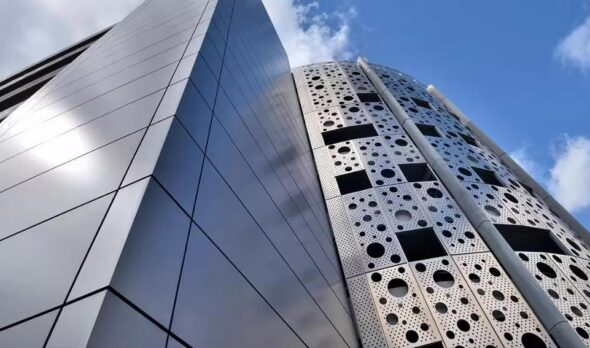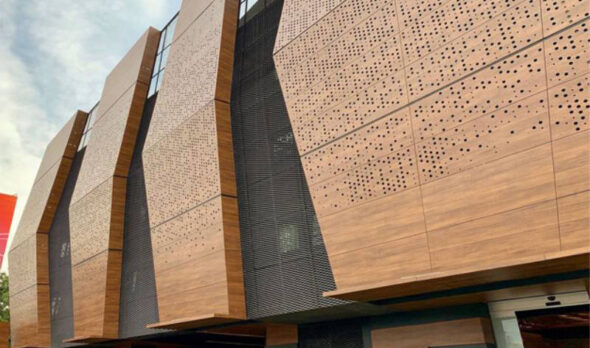Perforated facades
In architecture, facade perforation refers to the technique of enhancing the external appearance of a building by creating openings in the facade. This is done for both aesthetic and functional purposes, such as ventilation, lighting, and temperature regulation. The use of perforated facades is increasingly associated with modern commercial and multifunctional complexes, where a distinctive feature is the perforation of the ventilated curtain facade.
One common method of achieving perforation is through the use of perforated panels or composite sheets. The presence of openings in various shapes and sizes allows for the creation of diverse patterns. Panels can be made from various materials, primarily aluminum composite panels and High-Pressure Laminate (HPL) panels, each offering different stylizations to align with the architectural concept of the building. Perforation can be achieved through laser cutting or milling.
Perforated facades offer several advantages, including:
- Providing a unique appearance to the building.
- Facilitating ventilation and natural lighting inside.
- Creating a play of light and shadow.
- Controlling heat, noise, and privacy.
Perforating the facade is an effective way to combine functionality and design, allowing for the creation of an interesting exterior while improving the building’s comfort conditions.
Patterns of various shapes and complexities emphasize the exterior’s stylistic features and add a unique touch. Let’s explore the factors contributing to achieving such results, where the facade looks both technological and somewhat futuristic. In reality, the basis of such siding is not new; it involves facade cassettes, particularly those made of aluminum composite material (ACM), which have been widely used for decades in exterior wall decoration. The creation of openings through milling cassette elements results in perforated facade cassettes, and these elements can have substantial dimensions. As a result, perforated panels for ventilated facades (ACM, HPL) allow for perforated facades with a wide range of pattern designs.
It is worth noting that perforated facade elements may not necessarily be classic cassette panels with a standard trim, but rather linear perforated panels made of ACM. Production is carried out on computer numerical control (CNC) milling machines, and the cost is directly related to the length of milling. The more intricate the elements, the greater the linear footage, and consequently, the higher the product price.
Purchasing perforated facades from the specialized company Cut Facade means saving time, receiving expert consultation, and achieving excellent results.


